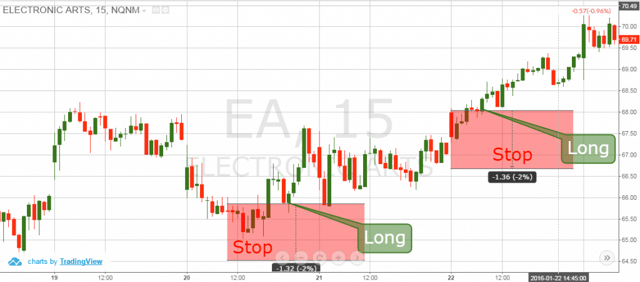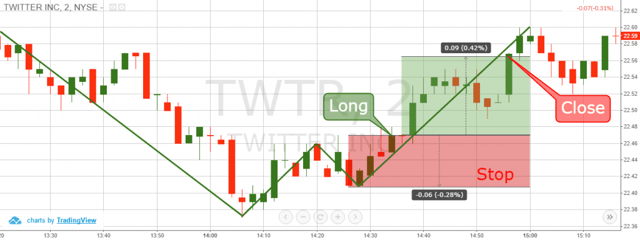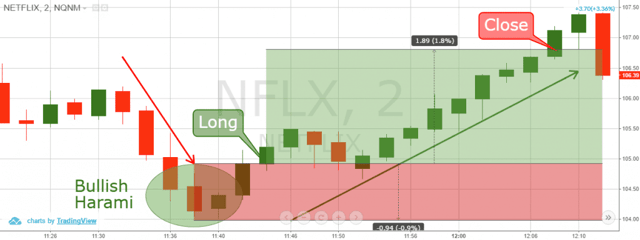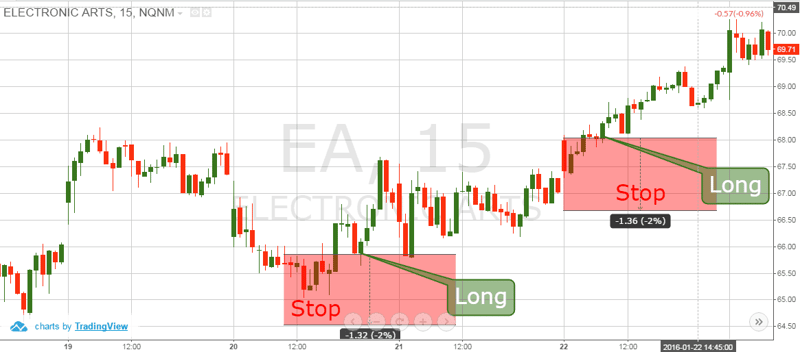Let’s really take a look at what risk is. Risk is the possibility of loss or injury, something that seems dangerous to us. Risk is uncertain, it is unpredictable. When you define trading risk, you are calculating the probability of a stock going up versus that of it going down. This is very useful because it allows you to weigh how much trading risk you are willing to take against the possibility of a gain in light of the uncertainty. It is essential to be willing to assume trading risk in order to achieve the desired result of profits.
Setting Goals
A great way handle the uncertainty in the markets is to set future oriented goals for yourself and then develop a trading strategy or trading system that will allow you to achieve that result. It is essential that you stay aligned with your goals and trading strategies; by doing this, you help to eliminate some of the uncertainty and establish trade risk management.
What Is An Appropriate Level Of Trading Risk?
It is difficult at times to draw a line between prudent risk and thoughtless risk. This will require considerable practice, preferably through paper trading. Also, you should work at gaining a better understanding of the company you are dealing with by performing fundamental analysis and technical analysis, and finally control your own psychological contribution to the process.
If you are too risk-averse, or “trading scared”, you will not have the stomach to hold your winning positions long enough to realize the potential profits that you expect. Conversely, if you are an action junkie and risk too much, you may get into a game of taking huge draw-downs and that can psychologically wear on your brain over the trading day. With concentration, you can learn to tolerate the uncertainty and ride out the uncomfortable feeling that a drawdown presents. After some time, you will begin to trade in the “zone”, a mindset of action, focusing on the here and now, without dwelling on your past mistakes or emotions. This will allow you to take proper levels of risk, balance and size your trading risk, and tolerate the uncertain nature of the trading risk.
Know Who You Are As A Trader
If you can get in touch with your core being, you can then shape your trading without any preconceptions at all. That is the key to success, to be liquid and adjust to different market environments without the ego and the hard hat.
Many traders say that the psychology of risk is the psychology of confidence. Confidence means knowing how to trade in all situations and this comes with practice and patience. If you get that feeling in your gut that you are “gambling”, you are probably not confident. Confidence comes from time-tested consistent gains. Be patient and follow your trading plan and confidence will naturally come. In your core, you know that a week or two of gains doesn’t make you a professional. Be honest with yourself.
Taking trading risks and conquering market uncertainty requires you to be on the cutting edge, learn new skills, and stick to your trading plan even in the face of difficulty. Drop your ego, allow yourself to be coached by others with experience. Do not be afraid to ask questions and don’t feel the need to be in control all the time. The best traders that I have seen are humble, resilient, and always looking to better their trading skills so that they can remain grounded and objective in handling their trading risk.
Additionally, taking risk and eliminating market uncertainty requires a trader to work on not getting distracted, augmentative, or even too opinionated. Be able to get smaller in trade size when your trades are going against you. Don’t allow your ego to play a big role in your trading activities by holding losing positions way longer than you should be, risking disaster. Be liquid and allow yourself to increase your skill set and learn new concepts.
#1 – Trading Plan
I find that you can ask yourself a few questions to keep yourself honest and better understand your trading style. Think of a few recent trades that you made, review the stock chart and ask yourself the following:
- What price did you enter the trade?
- Did you add additional shares as the stock went in your favor?
- Where did you sell out?
- Can you correlate your trading style to the manner in which you managed the trade?
- Did you buy shares near the bottom and then add more as the stock went up? Or did you buy and sell quickly once you landed a small profit?
- What lessons can you learn about your trading style from the way you managed this trade?
- How would others have traded this stock chart? What do you need to do in order to grow your trading style and the amount of risk you are willing to assume?
- What is holding you back from doing this?
- What is a sticking point for you that is preventing you to reach that next level; something that you have trouble with because it creates much anxiety and uncertainty?
- Do you have trouble buying/shorting more shares even when you are very confident that you are right? This line of questioning should help you understand who you are as a trader and what steps you need to take to improve your trading risk profile.
#2 – Stop Loss Risk Management
The best way to predefine the trading risk you are willing to take is to build a stop loss management plan. First of all, every time you are entering a trade, you need to have a stop loss in order to protect your bankroll. When you are working on your trading strategy, you should identify the percentage of the trade size you are willing to risk. When you find out this percentage, you should do a simple calculation in order to define the level at which your stop loss should be placed.
Let’s say your bankroll is $10,000. In this manner, after the maximum day trading leverage of 1:4, you will have buying power of $40,000. Now let’s say that the maximum trading risk you are willing to take equals 1% of your bankroll. This means that you are ready to risk 10,000 x 0.01 = $100 maximum in each of your trades. But the buying power you are managing is $40,000, right?
Now you need to define how much of your buying power you are willing to invest in each of your trades. Let’s say you want to invest 1/8 of your buying power ($40,000) in each of your trades. This means that you will be putting 40,000 x 1/8 = $5,000 in each of your deals. We will risk $100 (1% of the bank) in each trade with investing $5,000. In order to find out the proper location of your stop loss, you need to define what percentage $100 take from $5,000. We can find this out with a simple calculation:
100 / 5,000 = 2% (0.02)
In this manner, your stop loss should always be at a 2% distance from the entry price. This way you will always risk $100, which is 1% of your bankroll. Let’s have a look at the image below.

Stop Loss Orders
This is the 15-minute char of Electronic Arts for Jan 15 – 25, 2016. The image shows two long entries with their respective stop loss orders.
In the first case, we enter into a long trade with EA at $65.85 per share. In order to keep our 2% (1% Bankroll Risk) rule, we need to position our stop loss order $1.32 below the entry price. Let me show you the calculation:
$65.85 x $0.02 = 1.32
This means that our stop loss should be located at $65.85 – $1.32 = $64.53 per share.
In the second case we enter into a long trade with EA at $68.04 per share. We keep our 2% (1% Bankroll Risk) rule and we place the stop loss $1.36 below the entry price. Let’s do the math:
$68.04 x $0.02 = $1.36
Therefore, our stop loss should be located at $68.04 – $1.36 = $66.68 per share.
This way the two stop loss orders will cover a maximum loss equal to 2% of the amount we invest and 1% of our bankroll – $100 loss.
$100 is 1% of our $10,000 bankroll and 2% of the $5,000 we invest in each of our trades.
#3 – Return-to-Risk Ratio (Win-Loss)
In every trade you undertake you should have clearly stated goals. This means, you should always know how much you are ready to lose and what you are aiming for in terms of profit target. But how do you do that? Easy! The same way as with stop loss management. However, this time you manage your target.
In the example above, I showed you how to risk only 1% of your bankroll, which equals 2% of the amount you invest.
The same is in force with your target. If you aim for profit equal to 1% of your bankroll, you should catch a 2% increase if we take into consideration the rules from above. This way you will risk 1% of your bankroll (2% of the trade) and you will aim for 1% profit (2% increase). In this case you have 1:1 Return-to-Risk ratio, because you risk 1 to get 1.
1:1 is the minimum you should aim for if you implement high frequency trading and you open more than one trade per day. In other words, do not risk more than you aim for if you are a day trader.
However, there is an exception. If you implement a high probability strategy, where the success rate is more than 65-70%, then you can put a loose stop loss. The reason for this is that the stop will only be meant to protect you from rapid price moves against your trade. The loose stop loss could also be used when you leave your trades overnight (which I do not advocate).
Sometimes, when you want to trade a big gap, you can loosen your stop loss in order to cope with extremely high volatility during the opening bell.
Let’s now cover various risk to reward ratios when day trading.
- 5 : 1 Return-to-Risk Ratio
The image below will show you where your stops and targets should be if you want to attain 1:2 win-loss ratio.

Return to Risk Ratio
Above you see the 2-minute chart of Twitter for Dec 23, 2015. The image illustrates a trading situation, which provides 1.5:1 Win-Loss ratio.
We have a classic double bottom chart pattern in the image above. When the TWTR price breaks the trigger line of the pattern, we get a long signal. A stop loss should be placed below the last bottom of the pattern. Also, according to the double bottom rules, the potential of the pattern is the price to reach at least a bullish range equal to the size of the formation.
So, the stop loss should be located below the bottom $0.06 (6 cents) below the entry price, which is 0.28% risk. At the same time, the minimum target we pursue should equal the size of the formation. This is $0.09 (9 cents) above the entry price, which is a 0.42% target.
0.42 / 0.28 : 0.28 / 0.28
equals to 1.5 : 1 return-to-risk ratio.
- 2 : 1 Return-to-Risk Ratio
This time I will show you an example where the win-loss ratio is 2:1. Have a look at the following example:

2 to 1 Return to Risk Ratio
Now, we look at the 2-minute chart of Netflix from Aug 21, 2015. The image illustrates a bullish harami candlestick pattern, which we enter a long position with a 2:1 win-loss ratio.
In the green ellipse you see the bullish harami pattern which comes after a bearish trend. The candle which comes after the pattern is the trigger candle.
Therefore, we go long with the closing of the trigger candle as shown in the image above. The stop loss should be placed right below the candle pattern’s low point. This is $0.94 (94 cents) below the entry price, which equals 0.90%. We pursue 2:1 return-to-risk ratio. So, let’s calculate.
In order to get a 2:1 win-loss ratio, we need to double the amount we risk:
0.90% x 2 = 1.80% (target)
So, our actual win-loss ratio is 1.80% : 0.90%. Let’s check:
1.80% / 0.90 : 0.90% / 0.90 = 2 : 1 Return-to-Risk ratio
Of course, 1.5 : 1 and 2 : 1 are not the only options for win-loss ratio you should approach. They could vary the way you want. You should approach your own trading strategy with a certain return-to-risk ratio, which will satisfy your trading behavior. In this manner, there are win-loss ratios like 3:1, 4:1, 5:1, or whatever you want. Just remember something: The higher the win-loss ratio, the less the success rate of your strategy is likely to be. After all, if you pursue a 7:1 risk-to-return ratio with your strategy, if you have 70% success rate, you have essentially developed a winning strategy.
Just to clarify something on the stop loss, you do not have to allow your order to be triggered. If I am looking for a specific gain of let’s say 2% and the stock begins to fail, I will use time and sales to judge if I should exit a trade.
This way over time, your win ratio will continue to increase which, will increase your per average trade profit. It will also place you in a winner’s mindset as you get in a constant rhythm of pulling money out of the market.
#4 – Trailing Stop Loss Order (TSLO)
Profits will run in your favor to a point and then all of a sudden, things can go against you quickly.
If you are in a trade and the price moves in your favor, there is nothing wrong with adjusting your stop. This way you can lock in guaranteed profits.
The trailing stop is a regular on-chart market order, which gets you out of the trade, when specific requirements are met. As you probably guess, the name “trailing stop” is related with the character of the order. The trailing stop simply trails behind the price action, when the stock is trending in your direction. However, if the stock is moving against you, the trailing stop does not move.
Let’s say you buy Oracle at $35.00 per share and you place a trailing stop $0.35 (35 cents) below your entry price. This means that your trailing stop will get you out of the market at $34.65 if the price decreases immediately.
However, if ORCL enters a bullish trend and the price increases to $36.00 per share, then the trailing stop will be automatically adjusted at $35.65 per share. Since we entered at $35.00, we will have a locked-in profit of $0.65 (65 cents).
If after reaching $36.00 per share, the price begins to drop, the trailing stop holds at $35.65. Conversely, if the price begins to rise above $36, the trailing stop loss will move higher accordingly.
A key item to remember when placing trailing stops is to account of the volatility of the underlying security. Meaning if a stock has 3% moves per candle, a .5% trailing stop will be triggered.
Conclusion
- You should always have set goals when you implement your trading strategy. Ask yourself: What is my target and what loss am I ready to take to reach it?
- Examine your trading psychology. Are you too tight when you trade? Or maybe you are too aggressive in your trading? The answers to these questions might help when you develop your trade risk management rules.
- Trading is all about planning. Therefore, you should have your own trading plan. Create a list of questions, which you ask yourself in every trade. Take into consideration entry price and eventual outcomes.
- Always use a stop loss order when you buy or sell a stock. This way you will never lose more then you planned.
- If your trades give you a high success rate, pursue a lower win-loss ratio. If your trading strategy gives you a low success rate, but with high returns, stay tight and aim for the highest risk-to-return ratio.
- The trailing stop loss order is an ultimate way to implement trade risk management. Decide on the size of corrections you expect and use it to set the parameter of the TSLO. This way the stop will follow the price action, locking-in profit on the way up. At the same time, you will handle the corrective moves.










 Futures Trading Strategies
Futures Trading Strategies 
